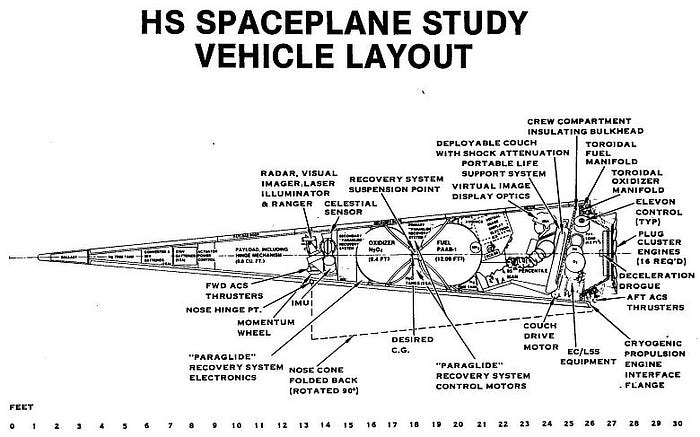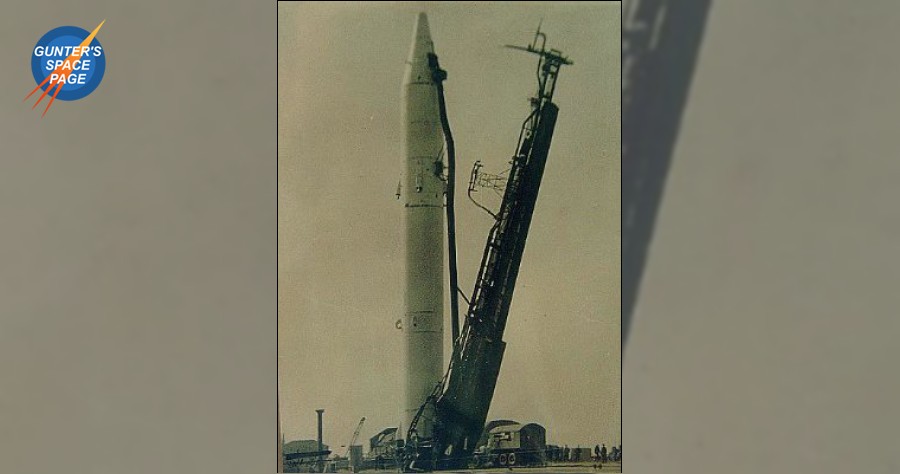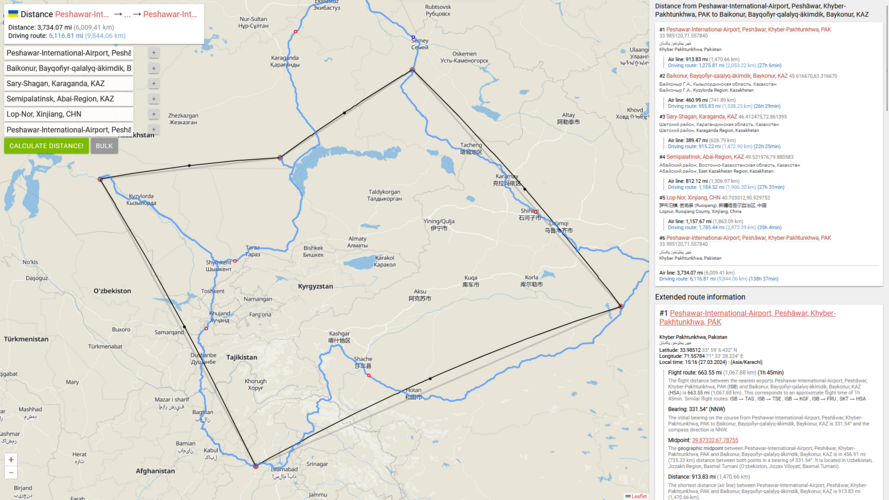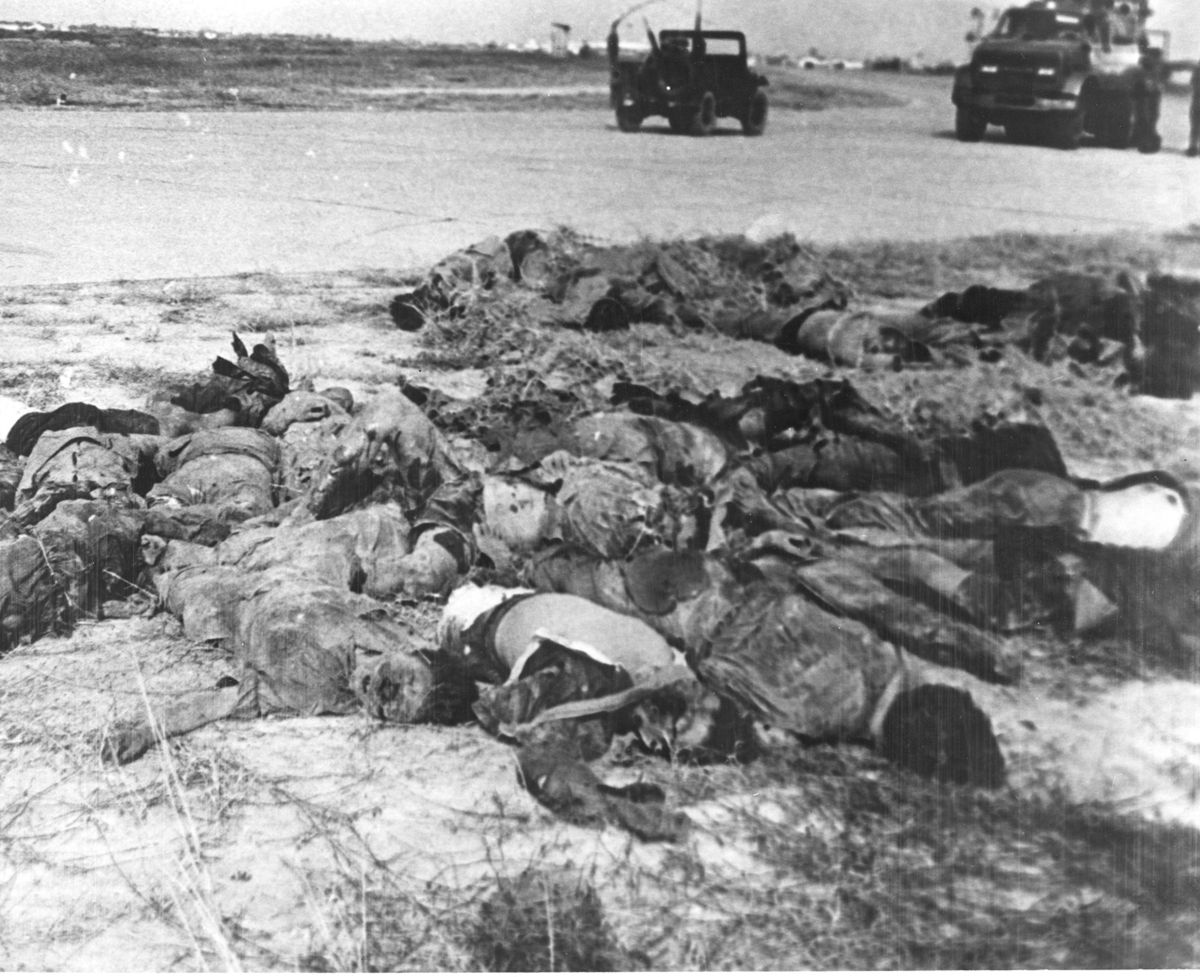https://en.wikipedia.org/wiki/Program_437
Johnston Island
1963
"Ever heard of Program 437 at Johnston Island ? no ? It is the closest thing in existence from an ASAT and a SAINT system: satellite killer or just satellite inspectors. We should really meet them and coordinate our efforts with that program.
"The US's first anti-satellite system was Program 505, based at the Kwajalein Missile Range: a little farther in the Pacific: about halfway between Hawaii and the Philippine islands. This system has become operational last year. Based on the Nike Zeus anti-ballistic missile that is being tested at that site. The missiles have been modified for greater range, but even with these modifications the system can only intercept satellites that fly very close to the base: maximum altitude around 170 miles. A system with longer range seemed like the next logical step, and this became Program 437. It is based on a Thor IRBM: in fact the missiles once deployed in Europe: Great Britain, Italy, Turkey. We have a stock of these decommissioned missile, and it would be a shame to waste them.
"Operation Fishbowl has launched eight Thor missiles last year: May 2, 1962 to November 1, 1962. The whole thing has been a bloody mess, all the way from the island itself to space. Bluegill Prime had a Thor exploding on the island and burning its plutonium bomb. A month later Starfish Prime fucked up power grids across the entire Pacific: also frying one-third of the satellites in orbit. They nonetheless proposed an ASAT program using the island infrastructure.
"Gimme a break... they want to throw nuclear-tipped Thors against Soviet satellites ?
"That's the basic concept, yes. Not in orbit: just direct ascent. Track the commie satellite, wait and calculate an approach, then launch the Thor and - KABOOM. If the satellite ain't vaporized, it will be fried either by the electromagnetic pulse or by the radiation."
"Sweet Jesus... well I don't see how this madness is of interest to us."
"There has been a recent development of Project 437 that is indeed more interesting to us. Well we should use it as template, and then thrieve on the system weaknesses : which are many. In my opinion, we can do much better than both 437 and 505 systems."
...
On 23 May 1963, the Air Force directed the Air Force Space Systems Division to study the possibility of using Program 437 to act as a satellite inspection system. Program 437AP (advanced payload) would provide the ability to examine an orbiting satellite.
This new program was vital if the president needed more information to determine whether an orbiting satellite constituted a threat to US national security and vital national interests and, thus, should be destroyed. Intelligence agencies, like the CIA, could look at a photograph to see if the space vehicle was an intelligence gathering, communications, or Multiple Orbit Bombardment Satellite.
The Air Force and General Electric, the developer of the defunct Satellite Inspector system, urged the Air Defense Command to take on Program 437AP and its satellite photographing mission. Program 437AP would incorporate a modified Mark 2 reentry vehicle using a camera from the National Reconnaissance Office’s (NRO) successful Corona imagery satellite.
On 9 December 1963, Under Secretary of the Air Force Brockway McMillan requested that LeMay complete a development plan for Program 437AP not later than 23 December. McMillan, who also served as the director of the NRO, may have had other reasons to develop Program 437AP. As the director of the NRO, he was responsible for much of the nation’s space reconnaissance efforts, including imagery. The Corona satellite was an integral part of the NRO’s assets. The capability to gather imagery intelligence of an orbiting Soviet intelligence satellite would allow the NRO to examine these systems close up.
Using the NRO’s camera from the Corona satellite, hence the term “Corona camera,” would reduce the cost and development time for the program. The Corona camera could take five to seven photographs in daylight at an altitude between 70 to 420 miles. After the Program 437AP inspector satellite photographed a target, it would eject a film canister as its orbit passed near Hawaii. A specially modified C-130 aircraft from Hickam AFB, Hawaii, would recover the film as it parachuted towards earth.
"Program 437AP’s concept of operations is simple. The Joint Chiefs of Staff (JCS) develop a satellite target list. The Air Defense Command’s mission is to photograph and analyze the targets and send the information to intelligence agencies for further review. The JCS priority target list allows the 10th Air Defense Squadron to schedule Thor preparations and arrange C-130 recovery support on a routine basis."
...
"See ? the NRO and CIA are interested in 437AP. And this is the exact place we step in. I want to snatch 437AP mission of imaging satellites: as HIGH TOWN secondary mission. Correcting 437 many limitations through air-launch and near real time film readout. Indeed several factors limit the feasibility of Program 437AP.
For a start the highest possible altitude possible using Thor boosters is 725 nautical miles. This ceiling let the Air Defense Command inspect targets only in low earth orbit.
Second, the recovery C-130 aircraft requires time to calculate and find the recovery site. The Johnston Island location, ground guidance system, and intercept geometry restrict the Program 437AP’s capability.
Third, the panoramic camera onboard the Thor can operate effectively only within certain parameters. The target satellite has to be illuminated in direct sunlight and the Thor needs to put the camera at a 45-degree crossing angle.
Fourth, the booster and payload do not separate until 160 seconds after liftoff, thus limiting the Program 437AP missions to a minimum intercept altitude of 100 nautical miles. The Air Defense Command crews estimate the optimal intercept altitude is 400 nautical miles at a maximum range of 800 nautical miles.
Finally, accurate tracking of space vehicles in high-drag orbits, below 250 nautical miles, is unreliable and interceptions below that altitude are impractical.
"I see. If played well, air launch and film readout will anihilate all five issues."
"My point exactly."
What Owen failed to grasp at this moment was that HIGH TOWN secondary mission opened new perspectives for Shoemaker. HIGH TOWN would start as a crisis reconnaissance spysat. And then it would shift to the Satellite Inspector mission. From there it would only take a small step to go ASAT. Probably not nuclear, as even Shoemaker acknowledged that Operations Dominic and Fishbowl had been nuclear insanity. Instead Shoemaker intended to go co-orbital with non-nuclear weaponry. As the 1960's came and gone, the Soviets provided Shoemaker with a dream target called FOBS: Fractional Orbital Bombing System.
----------------
Vandenberg AFB
California
1966
At Johnston island the 10th ADS kept both Thor boosters on ASAT alert for a dual launch capability. Countdown would proceed until T minus eight hours to launch. If it was to be a photographic inspection mission, the launch crew and support personnel would then remove and replace the nuclear warheads with a photographic payload on both Thors. Depending on the target, the Johnston Island or Vandenberg AFB ground guidance station would provide SPADATS, target intercept, and timing data along with other support to the launch crew.
A reserve launch crew at Vandenberg would stand ready to go to Johnston Island for further assistance. If deployed, this backup crew would transport a Thor booster to Johnston Island. The 10th ADS kept two cameras ready for launch and had a backup on the island. The other two cameras remained in storage at Vandenberg AFB. The 10th ADS required at least 15 days to refurbish and prepare the site to launch either another photographic or an ASAT mission.
Shoemaker pointed how air-launch vastly simplified logistics. Test flights would prove him right.
Douglas Aircraft contractors and 10th ADS crews conducted several Program 437AP test launches: from 7 December 1965 through 2 July 1966. They explored the capabilities of the primary panoramic and secondary index cameras. The tests required more precise guidance and interception data than 437 ASAT mission.
Several of these tests failed. However, the feasibility of Program 437AP had been proven. On 7 December 1965, a Thor-launched satellite photographed an expended Agena rocket body. The Thor’s payload flew within 0.56 nautical miles and took only 8.18 minutes to intercept the target. A subsequent launch on 18 January 1966 was another unqualified success. The Thor booster put the photographic payload within range of another Agena. And this time the the Air Force-crewed C-130 recovered the film capsule.
Another test launch on 12 March 1966 met with similar success. And Owen Gordon had been part of that: from the Lockheed side of the fence as usual. He had the Agena pictures framed on his desk. Officially, they had been taken by NASA Gemini astronauts.
He had to admit Shoemaker had been right, three years before. The possibility of photographing another nation’s satellites was an interesting proposition for US intelligence agencies. Except HIGH TOWN could do that far better than 437AP. To Shoemaker delight it had demonstrated the ability to uncloak “secret” Soviet space systems. It also thrieved on 437AP many flaws and limitations.
For example the Air Force had scheduled a fourth test launch for 6 April 1966 to photograph a Soviet satellite. The Joint Chief of Staf and the United States Intelligence Board (USIB) however vetoed the proposed mission for a couple of interesting reasons.
First, they thought the flight was too provocative. Shoemaker immediately countered by borrowing a NRO mission called Sat-Squared: satellite-to-satellite. Quite simply, it would use a very ordinary spysat to opportunistically image a Soviet satellite passing by: merely a secondary mission done quietly. In that regard, HIGH TOWN was far superior to GAMBIT or CORONA.
It would be launched for a reconnaissance and crisis mission, except by pure luck its orbit would provide a few close encounters with a Soviet satellite. Of course it wouldn't be pure luck but actually a deliberate move... except that, thanks to orbital mechanics singularities, it would be impossible to prove the deliberate side of that business. Plus HIGH TOWN Agena and Lunar Orbiter platforms had huge on-orbit delta-v to manoeuver from an initial, innocuous orbit. To another one where they could quietly go "sat squared" on that Soviet satellite. If played smart the deception would be almost too good to be true: there would be no provocation whatsoever.
Then Shoemaker found another argument to bury 437AP even deeper.
Despite the April 6 test being vetoed, Harold Brown, now secretary of the Air Force, requested funding from McNamara to support at least 10 more Program 437AP missions. Yet the spooks USIB opposed Program 437AP launches from Johnston Island.
The reason given: since the Soviets undoubtedly had identified that location as a hub for ASAT operations, they might well regard any launch from Johnston Island as a nuclear attack on their space assets. The USIB suggested the Air Force build another base to launch Program 437AP missions. However, because the costs to replicate the launch facilities were too high, enthusiasm for Program 437AP among DOD and national security agencies waned.
Shoemaker lost no time pointing that air-launch instantly nixed the issue, and requesting, too, ten missions. And he triumphed. The Air Staff not only decided not to build a separate Program 437AP launch facility. On 30 November 1966 they cannned 437AP altogether.
HIGH TOWN had carried the day. But for Shoemaker it was only a beginning: as FOBS entered the picture exactly at this point of time. He told Gordon it was almost too good to be true.
Despite increasing Soviet space activity in the 1960s, Program 437AP did not target any specific space threats: other than a hypothetical FOBS or MOBS deployment: fractional orbit or multiple orbits nuclear weapons.
This very mission however soon got a major boost from the CIA. Its 1966 National Intelligence Estimate projected that the Soviets had conducted several test FOBS launches, but the CIA was not convinced the launches would lead to a MOBS capability.
The following year, the CIA revealed that the USSR had been experimenting with a FOBS capability as early as 1965. The agency’s analysts concluded that the Soviets would likely deploy it. The CIA thought the Soviet Union had the ability to launch a few FOBS attacks against the United States and that Program 437 might be able to handle the threat.
The Soviet Union’s SS-9 ICBM was thought to be the FOBS booster. In the USSR’s 1965 May Day celebration, its Strategic Rocket Forces proclaimed that the SS-9 had “an orbital weapons application.”
As proof of this capability, the Soviets made no less than 15 test FOBS launches. Most of the tests were conducted from January to October 1967. On 25 January 1967 an SS-9, Cosmos 139, was launched from the Baikonur Cosmodrome and its payload landed 90 minutes later near the Soviet military rocket range of Kapustin Yar.
Secretary McNamara revealed that Cosmos 139’s purpose was an orbital nuclear weapons test. If the Soviets used FOBS to attack the United States, then the nation would not have adequate warning time for an immediate nuclear response. What if the SS-9 put the MOBS payload into a higher, more permanent orbit? Although short warning times made Program 437 a questionable defense against suborbital FOBS, the Thor-based ASAT weapon system might be capable of intercepting an orbiting MOBS.
Not only was short warning time a problem against a FOBS, so was the location of the Thor launch site. Indeed, Johnston Island’s location proved to be distinctly disadvantageous to the successful intercept of a FOBS threat. Since the FOBS was a suborbital weapon, its altitude would normally be below 250 nautical miles—not optimal for a Program 437 interception.
Additionally, as noted above, Soviet launches from less than 57 degrees or between 65 and 80 degrees latitude would be outside the coverage areas of then existing US radar systems.
Though the Thors could be launched to attack any target in any direction from Johnston Island, only those targets on a inclination between 57 and 65 degrees or above 80 degrees latitude would be detectable by US warning radar and thus susceptible to attack by the Thor. Incoming targets above 80 degrees latitude would likely be well out of range of Johnston Island. For example, if the Soviets used the Tyuratam space launch complex (or any other site) to launch a suborbital attack on a path between 49.5 to 50 degrees latitude, then the Thor could not intercept the incoming Soviet warhead(s).
When Shoemaker learned about all the above, he just couldn't believe his luck. Not only air-launch would, once again, anihilate every single of these issues: another victory for HIGH TOWN against 437AP. But there was more than that: even more exciting.
Shoemaker imagined to launch a HIGH TOWN to chase one of these FOBS spacecraft.
He wouldn't destroy it with a nuke, nor even with conventional weaponry - not at the beginning at least. Instead, the HIGH TOWN would image the FOBS: bringing back Satellite Inspector: SAINT.
Eventually after a few successful interceptions Shoemaker would found himself in a position of strength to move from SAINT to ASAT: from inspection to destruction. Crucially, HIGH TOWN flight profile was exactly a mix of FOBS and MOBS. That is: a fraction of an orbit; or just one complete orbit; or multiple orbits. And as such, it would be ideal to chase, image and eventually destroy the Soviet weapon.
Shoemaker had now between his hand a mission even more exciting that crisis reconnaissance. One that served his unflinching long term goal of Air Force space dominance across Earth sphere of influence: 1 million miles.
On 30 March 1967, the Continental Air Defense Command, a joint defense command that included the Air Defense Command, conducted a simulated orbital bomb system attack on the United States. The 10th ADS’s reaction was judged a success when a simulated ASAT payload intercepted a designated position in space within two nautical miles.
More than ever Shoemaker argued and insisted that the possibility of Soviet FOBS and/or MOBS strikes provided a new reason to retain a SAINT and/or ASAT capability. And that HIGH TOWN would do it far better than 437AP. His efforts were not in vain, as the Air Defense Command soon prooved they still believed in an ASAT mission.
But instead of a direct ascent system like Thor, the command requested that the Air Staff approve a replacement system based on a co-orbital interceptor. To Shoemaker delight, the Air Defense Command issued a required operational capability (ROC) statement that defined this proposed system on 17 March 1967.
It reflected the Air Defense Command’s desire to get the Air Staff to approve the development of a non-nuclear ASAT system. This system would intercept, inspect, negate, and conduct a post-attack assessment of a space vehicle. The Air Staff however disapproved the ROC and the Air Defense Command continued to operate Program 437.
Against that dismal background, Shoemaker proposed a different, phased approach. Involving HIGH TOWN spacecraft, obviously.
1-crisis reconnaissance
2-sat-squared (= opportunistic SAINT from ordinary spysats)
3-SAINT (= deliberate SAINT)
4-co-orbital ASAT.
HIGH TOWN secondary mission was more and more exciting - to Shoemaker at least. Gordon as usual was rather frightened by the prospects of harassing a Soviet orbital nuke platform. The same year 1968 Clarke published a companion novel to 2001. While it somewhat differed from the movie, it also provided interesting background to Heywood Floyd futuristic world. And Clarke wasn't exactly optimistic.
In the 2001 world, FOBS platforms were ubiquitous doosmday machines: deployed well beyond USSR.
...
"In a million years, the human race had lost few of its aggressive instincts; along symbolic lines visible only to politicians, the thirty-eight nuclear powers watched one another with belligerent anxiety. Among them, they possessed sufficient megatonnage to remove the entire surface crust of the planet. Although there had been - miraculously - no use of atomic weapons, this situation could hardly last forever.
And now, for their own inscrutable reasons, the Chinese were offering to the smallest have-not nations a complete nuclear capability of fifty warheads and delivery systems. The cost was under $200,000,000, and easy terms could be arranged. Perhaps they were only trying to shore up their sagging economy, by turning obsolete weapons systems into hard cash, as some observers had suggested."





